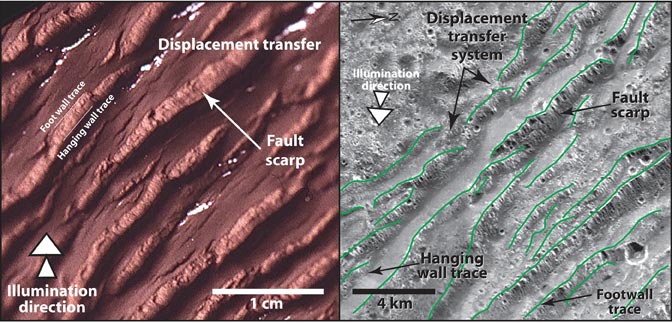Laboratory models suggest that stretching forces shaped Jupiter Moon's surface

Left Image: Courtesy of Southwest Research Institute; Right Image: Courtesy of NASA/JPL SSI image s0552443639 An image of a tabletop-size analog model (left) shows details of fault systems created by extension that visually match an image by spacecraft Galileo of faulted terrain on Ganymede (right).
Physical analog models simulate geologic structures in laboratory settings so that the developmental sequence of various phenomena can be studied as they occur.
The team – including researchers from SwRI, Wheaton College, NASA's Jet Propulsion Laboratory and NuStar Energy LP – created complex patterns of faults in their models, similar to the ridge and trough features seen in some regions of Ganymede. The models consisted of a “wet clay cake” material possessing brittle characteristics to simulate how the icy moon’s lithosphere, the outermost solid shell, responds to stresses by cracking.
The laboratory models suggest that characteristic patterns of ridges and troughs, called grooved terrain on Ganymede, result from its surface being stretched. “The physical models showed a marked similarity to the surface features observed on Ganymede,” said co-author Dr. Danielle Wyrick, a senior research scientist in the SwRI Space Science and Engineering Division.
“From the experiments, it appears that a process in which the crust breaks into separate blocks by large amounts of extension is the primary mechanism for creating these distinct features.”
“Physical analog modeling allows us to simulate the formation of complex three-dimensional geologic structures on Ganymede, without actually going to Ganymede,” said co-author Dr. David Ferrill, director of the Earth, Material and Planetary Sciences Department in the SwRI Geosciences and Engineering Division.
“These scaled models are able to reproduce the fine geometric details of geologic processes, such as faulting, and to develop and test hypotheses for landscape evolution on planetary bodies.”
SwRI researchers previously have used physical analog models to examine the process by which pit crater chains — a series of linear pits, or depressions — develop on Mars, and how magma in the Martian subsurface deforms the surface of the Red Planet.
NASA’s Outer Planets Research Program supported this work. The paper, “Physical models of grooved terrain tectonics on Ganymede,” by D.W. Sims, D.Y. Wyrick, D.A. Ferrill, A.P. Morris, G.C. Collins, R.T. Pappalardo and S.L. Colton, was published by Geophysical Research Letters, 16 June 2014, Volume 41, Issue 11, pages 3774–3778 , (doi 10.1002/2014GL060359).
Editors: An image is available at http://www.swri.org/press/2014/ganymede.htm.
For more information, contact Joe Fohn, (210) 522-4630, or Maria Martinez Stothoff, (210) 522-3305, Communications Department, Southwest Research Institute, PO Drawer 28510, San Antonio, TX 78228-0510
Media Contact
More Information:
http://www.swri.org/9what/releases/2014/ganymede.htm#.U71Ks2GKDcsAll latest news from the category: Physics and Astronomy
This area deals with the fundamental laws and building blocks of nature and how they interact, the properties and the behavior of matter, and research into space and time and their structures.
innovations-report provides in-depth reports and articles on subjects such as astrophysics, laser technologies, nuclear, quantum, particle and solid-state physics, nanotechnologies, planetary research and findings (Mars, Venus) and developments related to the Hubble Telescope.
Newest articles

Bringing bio-inspired robots to life
Nebraska researcher Eric Markvicka gets NSF CAREER Award to pursue manufacture of novel materials for soft robotics and stretchable electronics. Engineers are increasingly eager to develop robots that mimic the…

Bella moths use poison to attract mates
Scientists are closer to finding out how. Pyrrolizidine alkaloids are as bitter and toxic as they are hard to pronounce. They’re produced by several different types of plants and are…

AI tool creates ‘synthetic’ images of cells
…for enhanced microscopy analysis. Observing individual cells through microscopes can reveal a range of important cell biological phenomena that frequently play a role in human diseases, but the process of…





















